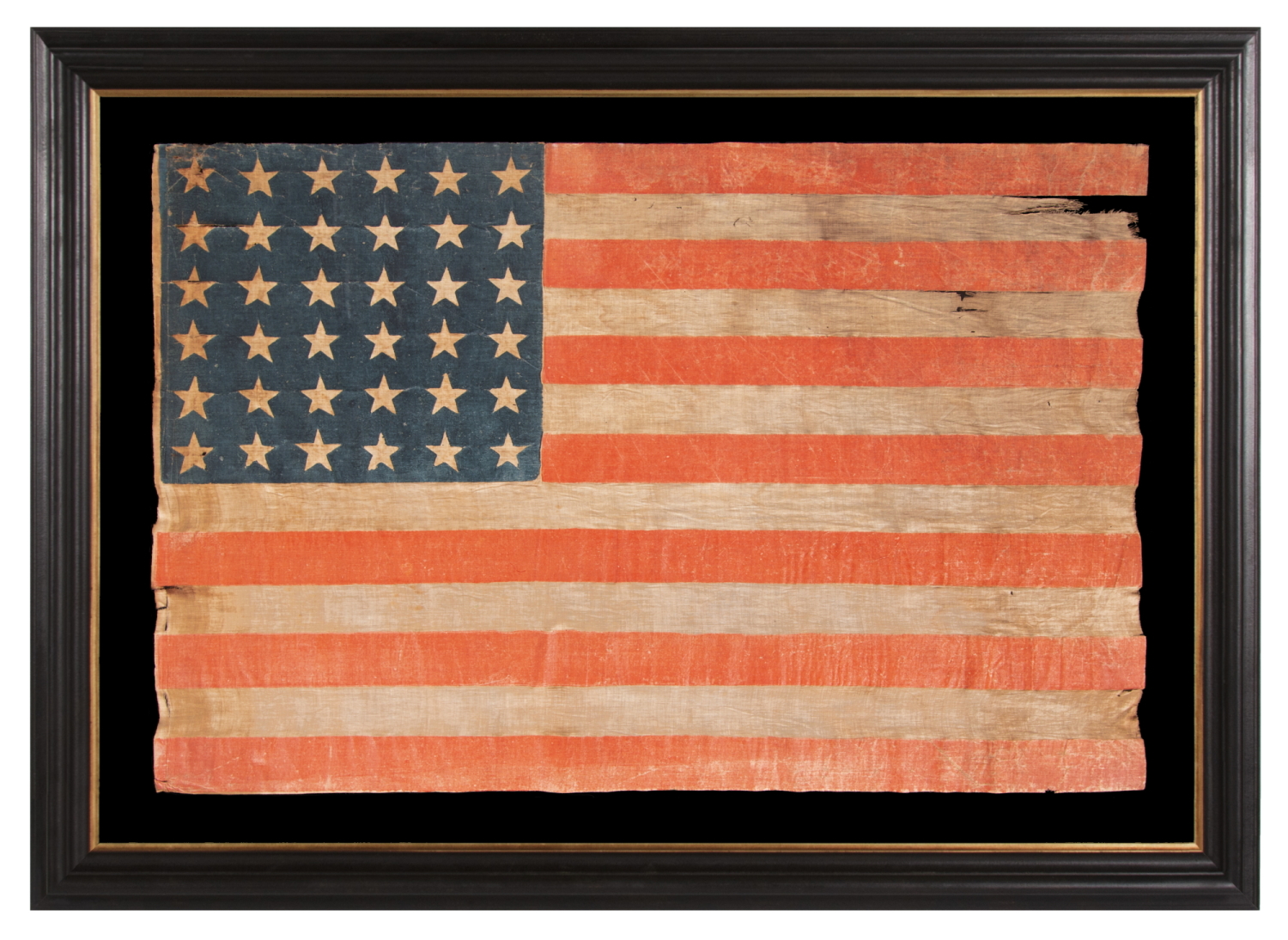
| |
36 STAR ANTIQUE AMERICAN PARADE FLAG OF THE CIVIL WAR ERA, IN AN ESPECIALLY LARGE SCALE, WITH BOLD COLOR, AND ENDEARING WEAR FROM EXTENDED USE, 1864-67, NEVADA STATEHOOD |
|
| Available: |
Sold |
| Frame Size (H x L): |
Approx. 40.25" x 54.5" |
| Flag Size (H x L): |
28.25" x 42.5" |
|
| Description....: |
|
Nevada joined the Union as the 26th state on Halloween Day, October 31st, 1864. Lincoln pushed Nevada through to statehood on October 31st, 1864, during the Civil War, and just 8 days before the November election. The territory’s wealth in silver was attractive to a nation struggling with the debts of war and so increased support for the Republican ticket. While the 36th star wasn't officially added until July 4th of the following year, some makers are known to have begun adding a 36th star as early as April of 1864, or even prior, months before the addition of Nevada actually occurred. This was a common practice during the late 19th century and is reflective of both the nation's desire for Westward Expansion and the hope of flag-makers to bring new star counts to market before their competitors. The 36 star flag was officially replaced by the 37 star flag in 1867, following the addition of Nebraska.
Parade flags generally measured three feet or less on the fly. At 42.5", this is a particularly large example. Before 1890, flags with pieced-and-sewn construction were typically 8 feet long and larger. Even infantry battle flags were 6 x 6.5 feet. Because printed parade flags were rarely as large as this one, and sewn flags were rarely this small, and because the size is relatively ideal--manageable but large enough to make a bold statement-- this is an especially desirable example.
In addition to its size, note the vibrant, chrome orange color of the stripes. Many cotton parade flags produced between 1850 and 1876 have shades of red that lean strongly toward orange. This was typical of the period and the presentation of these flags can be striking.
Mounting: The flag was mounted and framed within our own conservation department, which is led by expert staff. We take great care in the mounting and preservation of flags and have framed thousands of examples.
The gilded , American molding dates to the period between 1840 and 1870. To this a modern, rippled profile molding, black with gold highlights, was added as a liner. The background is 100% cotton twill, black in color, that has been washed and treated for colorfastness. The mount was placed in a black-painted and hand-gilded Italian molding. The glazing is U.V. protective acrylic (Plexiglas).
Condition: The flag displays legitimate wear extended use. There is moderate to significant oxidation throughout most of the white areas, the most significant of which occurs in the first column of stars, along the hoist end, and below them, in the stripes, along the hoist, and along the fly end, in an area that decreases in width as it descends. A small portion of the narrow, vertical, white edge is absent, in the upper, hoist end corner, approximately the height of the first three rows of stars, plus a narrow strip of the blue canton right next to it, approximately half the height of the white portion. Period fabric of similar coloration was placed behind the flag in these areas to mask the modest loss. There is some horizontal splitting in the canton, including within the first star, in the upper, hoist end corner, which is accompanied by a small hole, as well as in a line that connects the first two stars in the second row, and in a line across the first star in the third row. There are two tiny holes in the first star in the last row. There is some horizontal and vertical splitting along the hoist end, in the striped field, along where the flag was affixed to a wooden staff, with minor, associated loss. There is significant fabric breakdown, with associated loss, at the fly end of the 1st white stripe, accompanied by some tiny holes in the region closer to the center of the flag. There is horizontal fracturing, with associated loss, towards the end of the second white stripe. There are tiny holes, and some small nicks, and fracturing in the last two white stripes, at and near the fly end, and a small nick along the lower edge of the last stripe, in the same region. Many of my clients prefer early flags to show their age and history of use. |
|
|
|
| Collector Level: |
Intermediate-Level Collectors and Special Gifts |
|
| Flag Type: |
Parade flag |
|
| Star Count: |
36 |
|
| Earliest Date of Origin: |
1864 |
|
| Latest Date of Origin: |
1867 |
|
| State/Affiliation: |
Nevada |
|
| War Association: |
1861-1865 Civil War |
|
| Price: |
SOLD |
|
| |
Views: 1411 |
|
|
|

